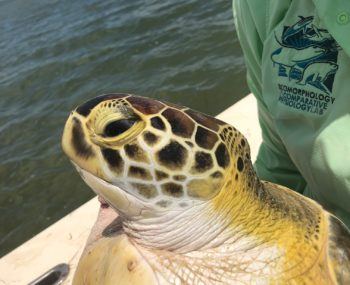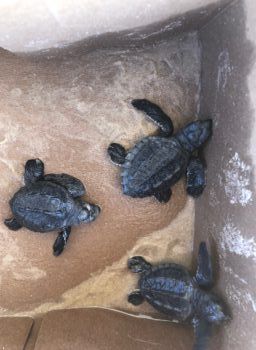New Sea Turtle Research Center Coming to Texas A&M-Galveston

Texas A&M University at Galveston will be the home of the new Gulf Center for Sea Turtle Research, with Department of Marine Biology Professor Dr. Christopher Marshall serving as the inaugural director.
The center will seek to use its strategic location and research expertise to facilitate the coordination of sea turtle experts from institutions across Texas and the Gulf of Mexico region to promote and support research that leads to restoration of sea turtle populations in the Gulf.
The primary goal of the center is to create a consortium that will enhance the efforts of individual researchers in support of programmatic grant proposals that individual researchers usually cannot access. Other goals include establishing research priorities, increasing cooperation and communication of researchers throughout the Gulf, training the sea turtle biologists of the next generation, and conducting sea turtle research in the region.
Colonel Mike Fossum, chief operating officer at TAMUG, said the new facility will be an important addition to research.
“Having the Gulf Center for Sea Turtle Research located in Galveston is not only a great opportunity for our university, but will be of great benefit to Galveston Island and the entire Gulf of Mexico region as we strive to ensure these creatures will always call these waters home,” he said.
Dr. Patrick Louchouarn, TAMUG’s chief academic officer, added, “I am grateful for the support of the Board of Regents through their recent approval of the creation of the center at TAMUG.

“The Galveston campus of Texas A&M continues to be a leader in matters of marine and coastal affairs and our scientists continually work to provide solutions to address our changing world,” he said. “I am grateful for the efforts of Dr. Christopher Marshall and Dr. Antonietta Quigg for their leadership in developing this center, which is designed to promote an interdisciplinary and international approach to solving current issues of sea turtle biology and their conservation.”
Participating groups that will help establish the Center include TAMUG, Padre Island National Seashore’s Sea Turtle Science and Recovery Division (National Parks Service), Texas Parks and Wildlife and the U.S. Fish and Wildlife Service.
Officials say the research center will fulfill a particular need in the western Gulf of Mexico, where data regarding local sea turtle populations is relatively incomplete compared with those in the eastern Gulf.
“I noticed that my colleagues from the eastern Gulf use the word ‘black box’ in terms of data for sea turtles from Texas and the western Gulf of Mexico,” Marshall said. “Right now in the western Gulf of Mexico there’s actually very few groups conducting sea turtle research.
“It just made me realize that we really need to pull together region-wide if we are going to make any progress.” Marshall said. “We need to get out of our silos and work cooperatively. Sea turtles have been underserved in this part of the Gulf. And that’s not through any lack of effort, but there’s only been a couple of camps doing the majority of the work. It’s a long coast. We need more scientists in this region studying sea turtles.”
In a huge boost of support, starting on April 29, the Texas Department of Motor Vehicles will have a Sea Turtle specialty license plate available for purchase. Part of the funds generated from the initial sale and the proceeding registrations will benefit the center and its research activities, such as our in-water sea turtle capture and tagging program.
“A major objective is to plan for the future,” Marshall said, “and that means providing incentives to start training sea turtle biologists here in Texas and the western Gulf of Mexico so that we can create a sustainable sea turtle research program over time. It takes sustained effort over decades to effectively manage sea turtle populations and we desperately need increased human resources to effectively do that,” he said.
Media contact: Patrick Temperilli, (409) 740-4783, temperilli@tamug.edu



